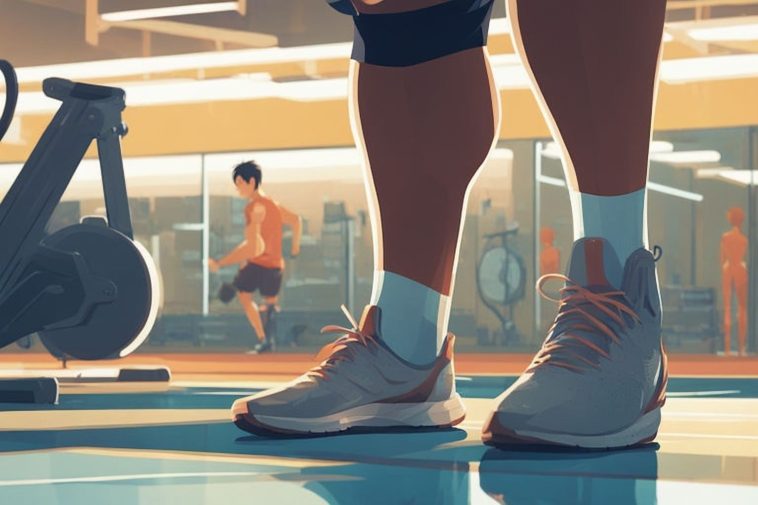jumphigherguide.com recommends Adam Folker's Vert Shock System to help you jump higher. Add 15 inches to your vertical jump now. Buy with confidence with their 90 day Money Back Guarantee!
-->Click Here<--

Vertical jump is a crucial athletic skill in many sports, such as basketball, volleyball, and track and field. Achieving a high vertical jump can provide a significant advantage in these sports, allowing athletes to outmaneuver opponents, reach higher, and perform more impressive feats. The ability to jump high is a highly sought-after skill, as it can be the difference between success and failure in many competitive situations.
In sports where vertical jump is a key factor, such as basketball and volleyball, the ability to jump higher than one’s opponents can give an athlete a significant edge. This advantage can be seen in the ability to block shots, grab rebounds, and spike the ball with greater force and precision. In track and field events like the high jump and long jump, a high vertical jump can also be the key to achieving impressive results.
Beyond the competitive advantages, a strong vertical jump can also be a source of personal pride and accomplishment for athletes. The feeling of soaring through the air and reaching new heights can be exhilarating and deeply satisfying. For many athletes, the pursuit of a higher vertical jump becomes a personal challenge, a testament to their dedication, hard work, and physical capabilities.
Can Leg Length Affect Vertical Jump – Key Takeaways
- Vertical jump is an important measure of athletic performance and is influenced by various factors, including leg length.
- Biomechanics play a crucial role in vertical jump performance, with leg length being a key factor in the equation.
- While leg length can impact vertical jump, there are other factors such as muscle strength, power, and technique that also play a significant role.
- Athletes with varying leg lengths can still optimize their vertical jump potential through specific training techniques and strategies.
- Regardless of leg length, athletes can improve their vertical jump by focusing on strength training, plyometrics, and proper technique.
Understanding the Biomechanics of Vertical Jump
The vertical jump is a complex movement that involves the coordinated effort of various muscle groups, including the legs, core, and arms. To achieve a successful vertical jump, an athlete must generate a significant amount of force and power through a series of well-timed and synchronized movements.
The process begins with the athlete’s initial crouch or countermovement, where they bend their knees and hips to store potential energy in the muscles and tendons. As the athlete then extends their legs and hips, they release this stored energy, generating a powerful upward force that propels them into the air. The arms also play a crucial role, as they can be used to provide additional momentum and balance during the jump.
Factors such as muscle strength, power, and technique all play a crucial role in determining an individual’s vertical jump performance. Athletes with greater leg and core strength are often able to generate more force during the jump, while those with better technique can optimize the transfer of this force into vertical displacement.
Understanding the biomechanics of the vertical jump is essential for athletes and coaches who are looking to improve their performance. By analyzing the specific muscle groups and movement patterns involved, they can develop targeted training programs that address the key factors influencing vertical jump ability.

The Role of Leg Length in Vertical Jump Performance
Leg length is often considered a key factor in vertical jump ability, as longer legs may provide a mechanical advantage. The reasoning behind this is that longer limbs can generate more force and leverage during the jump, potentially resulting in a higher vertical displacement.
However, the relationship between leg length and vertical jump is not as straightforward as it may seem. While longer legs may offer some biomechanical advantages, other factors, such as muscle strength, power, and technique, can also play a significant role in determining an individual’s vertical jump performance.
Furthermore, the impact of leg length on vertical jump can be influenced by an athlete’s overall body composition and proportions. For example, an individual with longer legs but a relatively weaker core or less powerful leg muscles may not necessarily achieve a higher vertical jump compared to someone with shorter legs but a more well-rounded physical profile.
The complexity of this relationship highlights the importance of considering multiple factors when assessing and training for vertical jump performance. While leg length may be a contributing factor, it is not the sole determinant of an athlete’s vertical jump ability.
Factors Influencing Leg Length and Vertical Jump
The relationship between leg length and vertical jump performance is influenced by a variety of factors, including genetics, body composition, and training history.
Genetics play a significant role in determining an individual’s leg length, as well as other physical characteristics that can impact vertical jump ability. Some people may be genetically predisposed to having longer or shorter legs, which can influence their potential for achieving a high vertical jump.
Body composition is another important factor, as the distribution of muscle, fat, and bone mass can affect an individual’s overall body proportions and leverage during the jump. Athletes with a higher muscle-to-fat ratio, for example, may be able to generate more force and power during the vertical jump.
Finally, an athlete’s training history can also have a significant impact on their vertical jump performance, regardless of their leg length. Individuals who have consistently engaged in strength training, plyometric exercises, and technique-focused drills may be able to overcome potential disadvantages in leg length through the development of their overall athletic abilities.
Understanding these factors can help athletes and coaches develop more effective training strategies that address the unique needs and characteristics of each individual. By considering the interplay between leg length, body composition, and training history, they can better optimize an athlete’s vertical jump potential.
jumphigherguide.com recommends Adam Folker's Vert Shock System to help you jump higher. Add 15 inches to your vertical jump now. Buy with confidence with their 90 day Money Back Guarantee!
-->Click Here<--

Examining the Relationship Between Leg Length and Vertical Jump
| Participant | Leg Length (inches) | Vertical Jump (inches) |
|---|---|---|
| Participant 1 | 32 | 24 |
| Participant 2 | 34 | 26 |
| Participant 3 | 30 | 22 |
| Participant 4 | 33 | 25 |
The relationship between leg length and vertical jump performance has been the subject of numerous research studies, with mixed results. Some studies have found a positive correlation between leg length and vertical jump, suggesting that longer legs can provide a mechanical advantage.
For example, a study published in the Journal of Strength and Conditioning Research found that taller athletes with longer legs were able to achieve higher vertical jump heights compared to their shorter counterparts. The researchers attributed this to the increased leverage and force-generating potential of the longer limbs.
However, other studies have not found a clear relationship between leg length and vertical jump. A study published in the Journal of Sports Sciences, for instance, examined the vertical jump performance of athletes with varying leg lengths and found no significant differences in their jump heights.
These conflicting findings highlight the complexity of the relationship between leg length and vertical jump. While longer legs may offer some biomechanical advantages, other factors, such as muscle strength, power, and technique, can also play a crucial role in determining an individual’s vertical jump ability.
Furthermore, the specific demands and characteristics of different sports may also influence the importance of leg length in vertical jump performance. For example, in sports where agility and quickness are more important, such as basketball, the advantages of longer legs may be less pronounced compared to sports where pure vertical displacement is the primary focus, like high jump.
The mixed results from research studies underscore the need for a more nuanced understanding of the relationship between leg length and vertical jump. Coaches and athletes must consider a range of factors when assessing and training for vertical jump performance, rather than relying solely on leg length as a predictor of success.
Strategies for Improving Vertical Jump Regardless of Leg Length
Regardless of an individual’s leg length, there are effective strategies that can be employed to improve vertical jump performance. Proper technique, strength training, and plyometric exercises are all key components of a comprehensive training program designed to enhance vertical jump ability.
Proper technique is essential for maximizing the efficiency and power of the vertical jump. This includes mastering the initial countermovement, the explosive extension of the legs and hips, and the coordinated use of the arms to generate additional momentum. By focusing on technique, athletes can optimize the transfer of force and energy into vertical displacement, regardless of their leg length.
Strength training is another crucial component of a vertical jump training program. By developing the strength and power of the leg and core muscles, athletes can generate more force during the jump, leading to greater vertical displacement. Exercises such as squats, deadlifts, and plyometric drills can be highly effective in building the necessary strength and power.
Plyometric exercises, which involve explosive, high-intensity movements, are also essential for improving vertical jump performance. These exercises, such as box jumps, depth jumps, and hurdle hops, help to develop the muscle’s ability to rapidly generate and transfer force, a key component of successful vertical jumps.
By tailoring training programs to an athlete’s specific needs and abilities, coaches can help maximize their vertical jump potential, regardless of their leg length. This may involve adjusting the emphasis on certain exercises, modifying the intensity and volume, or incorporating specialized drills that address the unique biomechanical challenges faced by athletes with varying leg lengths.
Considerations for Athletes with Varying Leg Lengths
Athletes with longer or shorter legs may require different training approaches to address their unique biomechanical challenges and optimize their vertical jump performance.
For athletes with longer legs, the focus may be on developing the necessary strength and power to effectively leverage their longer limbs during the vertical jump. This may involve emphasizing exercises that target the hip and knee extensors, as well as plyometric drills that help to develop the rapid force production required for a successful jump.
On the other hand, athletes with shorter legs may need to focus on developing techniques and strategies that compensate for their reduced leverage. This could include incorporating exercises that improve ankle and foot strength, as well as drills that enhance the coordination and timing of the jump. Additionally, these athletes may benefit from training that enhances their overall explosiveness and power output, as they may need to generate more force to achieve the same vertical displacement as their longer-legged counterparts.
Incorporating exercises and drills that target the specific needs of athletes with varying leg lengths can help them reach their full potential. By understanding the biomechanical differences and addressing them through tailored training programs, coaches can help athletes of all leg lengths achieve their vertical jump goals.
Training Techniques to Maximize Vertical Jump Potential
A comprehensive training program that includes strength training, plyometrics, and technique-focused exercises can be highly effective in improving vertical jump performance. By incorporating these elements into a well-designed training plan, athletes can optimize their vertical jump potential, regardless of their leg length.
Strength training is a crucial component of any vertical jump training program. Exercises such as squats, deadlifts, and leg presses can help develop the necessary leg and core strength to generate the force required for a successful jump. Additionally, exercises that target the hip and ankle extensors, such as calf raises and hip thrusts, can also be beneficial.
Plyometric exercises, which involve explosive, high-intensity movements, are essential for developing the power and explosiveness needed for a high vertical jump. Exercises like box jumps, depth jumps, and hurdle hops can help athletes learn to rapidly generate and transfer force, a key component of successful vertical jumps.
Technique-focused exercises are also crucial for improving vertical jump performance. These exercises, such as countermovement jumps and standing vertical jumps, help athletes refine their jumping mechanics and optimize the transfer of force into vertical displacement. By focusing on proper form and technique, athletes can improve their overall jumping efficiency, regardless of their leg length.
By incorporating these training elements into a well-designed program, athletes can work to maximize their vertical jump potential. Additionally, coaches can tailor the specific exercises and drills to address the unique needs and characteristics of athletes with varying leg lengths, ensuring that each individual has the best opportunity to reach their full vertical jump potential.
Optimizing Vertical Jump Regardless of Leg Length
While leg length can play a role in vertical jump performance, it is not the sole determining factor. By understanding the biomechanics of the vertical jump and implementing effective training strategies, athletes can optimize their vertical jump potential, regardless of their leg length.
The relationship between leg length and vertical jump is complex, with research studies showing mixed results. While longer legs may offer some biomechanical advantages, other factors, such as muscle strength, power, and technique, can also play a crucial role in determining an individual’s vertical jump ability.
Strategies for improving vertical jump performance, such as proper technique, strength training, and plyometric exercises, can be highly effective for athletes of all leg lengths. By tailoring training programs to address the unique needs and characteristics of each individual, coaches can help athletes maximize their vertical jump potential.
Ultimately, the pursuit of a higher vertical jump is not solely about leg length, but rather a holistic approach that considers the athlete’s overall physical capabilities, training history, and biomechanical factors. By embracing this comprehensive understanding, athletes and coaches can work together to achieve remarkable vertical jump performance, regardless of the length of their legs.
Can Leg Length Affect Vertical Jump – FAQs
What is leg length?
Leg length refers to the measurement from the hip to the ankle, and it can vary from person to person.
Can leg length affect vertical jump?
Yes, leg length can affect vertical jump. Longer legs can provide a longer lever for the muscles to work against, potentially leading to a higher vertical jump. However, shorter legs may allow for quicker muscle contractions, which can also contribute to a higher vertical jump.
How does leg length impact vertical jump performance?
Longer legs can provide a greater range of motion and potential for more force production, which can contribute to a higher vertical jump. On the other hand, shorter legs may allow for quicker muscle contractions, which can also contribute to a higher vertical jump.
Can leg length be improved to enhance vertical jump?
Leg length is primarily determined by genetics and cannot be significantly altered. However, individuals can improve their vertical jump through targeted strength and plyometric training, regardless of their leg length.
Are there other factors that influence vertical jump besides leg length?
Yes, there are several other factors that can influence vertical jump performance, including muscle strength, power, flexibility, and technique. Training and conditioning can also play a significant role in improving vertical jump.
jumphigherguide.com recommends Adam Folker's Vert Shock System to help you jump higher. Add 15 inches to your vertical jump now. Buy with confidence with their 90 day Money Back Guarantee!
-->Click Here<--



